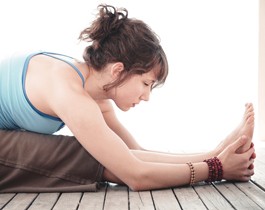10.07.09
YUMMY DELICIOUS: Yoga teachers never say ‘ow.’ They say ‘yum’ or ‘delicious.’ Yoga teachers are different from you and me.
A softer, gentler form of yoga seems to be quietly on the rise.
From Los Angeles to London, so-called yin yoga is increasingly being taught at studio classes and yoga retreats, not to mention via books and DVDs.
The power or “yang-styled” yoga forms so popular in the West, with their fast shifts between poses and emphasis on sweat, have left a gap for more meditative, longer-held stretches, says Paul Grilley, a martial arts and yoga practitioner who helped develop the yin yoga style along with fellow proponent Sarah Powers.
He says yin yoga is not a new form, but rather a return to more meditative, traditional yoga. Slower forms, such as restorative yoga, already exist, he acknowledges, relying on props to aid with poses and encouraging students to stop when they start to feel discomfort.
But with yin yoga, he says, the emphasis is not on a lack of pain, but rather on how to feel discomfort, stay with it and move through it.
Yin yoga relies on several core poses that, on first look, do not appear difficult. Most focus on the lower half of the body, such as the hips, pelvis, inner thighs and lower spine. The difficulty lies in the length of time the poses are held without shifting or movement.
Each pose is held from two to 20 minutes, and long, deeply held breaths coincide with the stretches. This provides for a meditative and mind-clearing practice that helps practitioners learn how to focus on the moment, proponents say, thus reducing anxiety, tension and stress.
Some of the names and yin poses are similar to their yang counterparts, such as “corpse pose” and “child’s pose,” though most have been altered and renamed.
The faster-paced yang-style yoga, such as ashtanga or vinyasa, targets lengthening and strengthening the muscles, says the Oregon-based Grilley, who teaches yoga nationally and internationally and wrote Yin Yoga: A Quiet Practice in 2002. Taoist-based yin yoga targets the connective tissues, ligaments, joints and synovial fluid and the energy channels or meridians that the philosophy hypothesizes runs through them.
Adds the San Francisco–based Powers, “This means that instead of coming into a pose for a short amount of time and hugging the bones close together by engaging our muscles, [one] needs to pull the skeleton apart nonaggressively and with appropriate pressure, and then remain stationary a while, allowing the muscles to remain stretched but without engaging them.”
Yin poses are not an attempt to stretch the ligaments and connective tissue but to load them appropriately, she says. Kelly McGonigal, a yoga instructor and psychologist at Stanford University and the editor of the International Journal of Yoga Therapy, elaborates.
“The fourth minute [of a stretch] is not like the first,” she says. “If you pull something fast and hard, you don’t get a benefit. But if you keep applying moderate, slow and longer pressure, it will eventually relax.”
Yin yoga’s proponents say the physical effects can have a profound emotional component as well, by teaching practitioners how to handle discomfort and strong sensations. For that reason, yin yoga is being used in some addiction- and trauma-recovery programs.
Dina Amsterdam, a San Francisco–based yoga teacher who teaches yin retreats nationwide, says she’s found that this form of yoga has emotional and spiritual benefits that “really outweigh what you’d think the benefits could be for a seemingly simpler practice like yin.” The centered and contemplative breathing seems to help release emotion, much like thawing ice, she says.
Also, because much of the stretching is done when the body is cooler, as opposed to yang yoga, in which the muscles have been warmed up, the resulting discomfort helps train the nervous system to be less reactive to the stress of a stretch, McGonigal says.
Molly Lannon Kenny, founder and executive director of the Samarya Yoga Center in Seattle, says this form of yoga is especially rewarding for eager-to-recover addicts and trauma survivors because of the need to work through the discomfort—basically waiting it out.
“For addicts, when they feel that overwhelming, I-have-to-have-that sensation—i.e., I have to have that cigarette, food, drink, drug or whatever—they learn to feel it, sit with it and see how this challenge unfolds, and see that it [both the physical discomfort and the emotional tension] can indeed pass safely,” she says.
As for the injury potential in muscles that aren’t warmed up, South Bay yoga instructor Via Page says, “Yin yoga poses are long, held stretches, so no warming up is necessary. Actually, the yin yoga poses themselves are essentially a warm-up practice.”
As for those emotional benefits, they’re not limited to those who have suffered trauma, Page says. “I’ve had many students tell me it’s helped them learn to become more deeply relaxed and less angry and stressed-out all the time,” she says.
That doesn’t mean yin yoga stress on inner de-stressing will overtake the hotter, sweatier yang.
“Yin yoga might be a hard sell in an environment where students want a real cardio experience,” Page says, “but despite this, yin is growing and will continue to grow. Once students get started, they can easily see the benefits of adding yin yoga to the mix.”
It’s important to remember that we need both yin and yang, she points out. “Yin makes us very flexible and helps us with a more spiritually meditative way of doing things, but we need strength-building, as well. We need them both.”











